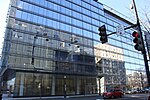Loeb's NY Deli
1959 establishments in Washington, D.C.Ashkenazi Jewish culture in Washington, D.C.Ashkenazi Jewish restaurantsDowntown (Washington, D.C.)Jewish delicatessens in the United States ... and 3 more
Kosher style restaurantsRestaurants established in 1959Restaurants in Washington, D.C.

Loeb's NY Deli is a historic kosher-style deli in downtown Washington, D.C., United States. Opened in 1959 by Walter Loeb, the deli was originally located at the corner of 15th and G Streets, NW, in a space currently occupied by the Old Ebbitt Grill. In the 1970s the deli moved to the U.S. Export-Import Bank (Lafayette) building, and was made to move again in 2010 because of a Recovery Act-funded renovation. It is now located at 1712 I Street, and run by Dave, Marlene and Steve Loeb, the children of founder Walter Loeb.
Excerpt from the Wikipedia article Loeb's NY Deli (License: CC BY-SA 3.0, Authors, Images).Loeb's NY Deli
I Street Northwest, Washington
Geographical coordinates (GPS) Address Nearby Places Show on map
Geographical coordinates (GPS)
| Latitude | Longitude |
|---|---|
| N 38.901166666667 ° | E -77.040222222222 ° |
Address
I Street Northwest 1716
20006 Washington
District of Columbia, United States
Open on Google Maps







